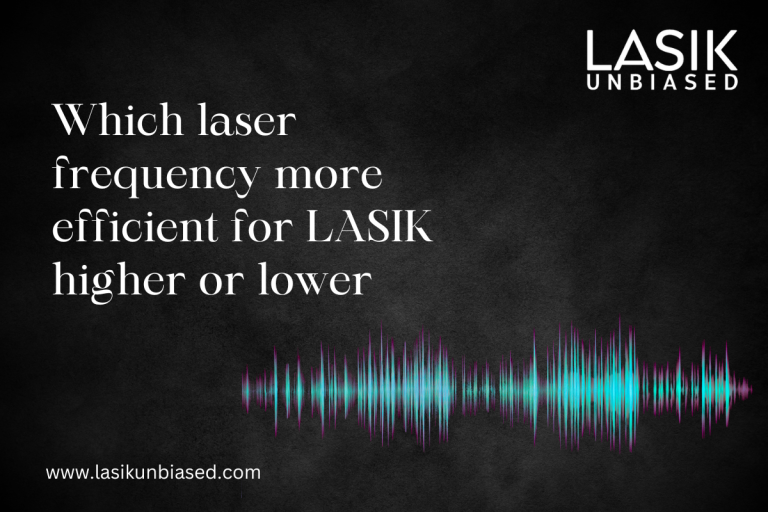Laser-assisted in Situ Keratomileusis (LASIK) is one of the most popular and effective vision correction procedures. It uses a laser to reshape the cornea to improve vision and reduce dependency on glasses or contact lenses.
The laser frequency is key to LASIK’s success, which affects precision, healing, and overall patient experience. Many wonder whether a higher or lower laser frequency is more efficient for LASIK. Understanding the role of laser frequency can help make informed decisions about the procedure.
What is Laser Frequency in LASIK?
Laser frequency refers to the number of laser pulses emitted per second during the LASIK procedure. Excimer lasers, which are commonly used in LASIK, operate at frequencies measured in Hertz (Hz). Modern LASIK lasers typically range from 50 Hz to over 1000 Hz, with different models offering various advantages.
Higher-frequency lasers emit more pulses per second, allowing for quicker corneal reshaping. Lower-frequency lasers, on the other hand, operate at a slower rate but may provide a different approach to energy delivery. Choosing between high and low laser frequency depends on precision, safety, and patient comfort.
Benefits of Higher Laser Frequency in LASIK
Faster Treatment Time
Higher-frequency lasers, such as those operating at 500 Hz or more, can complete the corneal reshaping process in seconds. This reduces the time the patient spends under the laser, minimizing discomfort and improving overall efficiency.
Improved Precision
High-frequency lasers allow for smaller, more precise corneal ablations. This precision enhances visual outcomes and reduces the risk of irregularities, leading to sharper vision and better night vision than lower-frequency lasers.
Reduced Risk of Corneal Dryness
Shorter exposure time to the laser reduces corneal dehydration, which can contribute to post-surgery dry eye symptoms. Patients treated with high-frequency lasers often experience less severe dry eye symptoms than those with lower-frequency lasers.
Faster Recovery
Since higher-frequency lasers operate quickly, they minimize the duration of corneal exposure to laser energy. This can lead to faster healing and reduced inflammation, allowing patients to return to normal activities sooner.
Advantages of Lower Laser Frequency in LASIK
Controlled Energy Delivery
Lower-frequency lasers, such as those operating at 50–200 Hz, deliver energy slower, which can benefit some patients. A slower approach allows for precise energy placement, reducing the chances of excessive tissue removal.
Reduced Heat Generation
Lower-frequency lasers produce less heat than their high-frequency counterparts. Excessive heat can damage corneal tissue and affect healing, so a lower-frequency laser may be a safer option for patients with thinner corneas or higher prescriptions.
Stability and Accuracy
Although higher-frequency lasers are fast, lower-frequency lasers can sometimes provide better corneal surface smoothness. This ensures the cornea maintains a more natural shape post-surgery, potentially reducing higher-order aberrations that could affect vision quality.
Which Laser Frequency is More Efficient?
Efficiency in LASIK depends on multiple factors, including speed, precision, safety, and patient comfort. Due to their speed and precision, higher-frequency lasers are generally preferred for most patients, but lower-frequency lasers still have a role in specific cases.
When Higher-Frequency Lasers Are Better
- Patients with mild to moderate refractive errors who want a quicker procedure
- Individuals seeking faster recovery times
- Those concerned about dry eyes after LASIK
- Patients who prefer advanced laser technology for enhanced precision
When Lower-Frequency Lasers Are More Suitable
- Patients with very high prescriptions requiring significant corneal reshaping
- Individuals with thinner corneas, where controlled energy application is crucial
- Those who prefer a more gradual approach to laser correction
- Patients at risk of excessive heat buildup during laser treatment
The Evolution of LASIK Laser Technology
Over the years, LASIK technology has advanced significantly, developing faster and more efficient lasers. Early excimer lasers operated at lower frequencies, requiring longer treatment times. Modern lasers operate at speeds exceeding 1000 Hz, significantly improving the patient experience.
Other Factors Affecting LASIK Outcomes
While laser frequency plays a crucial role, other factors also impact LASIK results, including:
- Wavefront Technology: Custom LASIK procedures use wavefront mapping to create a personalized treatment plan, improving accuracy and reducing side effects.
- Corneal Thickness: Patients with thinner corneas may require specific laser settings to ensure safety and effectiveness.
- Surgeon Expertise: The LASIK surgeon’s experience and skill influence how well the laser frequency is utilized for optimal results.
- Pre-Existing Eye Conditions: Dry eyes, astigmatism, or corneal irregularities may require tailored laser treatment approaches.
Both higher and lower laser frequencies offer unique benefits in LASIK surgery. Higher-frequency lasers provide faster treatment, improved precision, and quicker recovery, making them the preferred choice for most patients. However, lower-frequency lasers offer controlled energy delivery and reduced heat generation, making them suitable for specific cases requiring a more delicate approach.
The best laser frequency for LASIK depends on individual eye conditions, corneal thickness, and personal preferences. Consulting with an experienced LASIK surgeon can help determine the most suitable laser technology for achieving the best vision correction results. Laser frequencies will improve as technology advances, ensuring safer and more effective LASIK procedures for patients worldwide.


